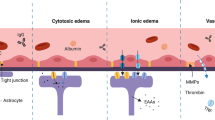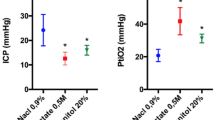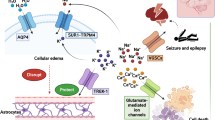Summary
Traumatic head injury leads to marked swelling of endothelial cells, both in human patients and in Marmarou's rat model. We used this model to test the hypothesis of mechanogated ion channels being involved in the formation of traumatic brain oedema. All mechanogated channel blockers tested (gadolinium, amiloride, gentamicin) significantly reduced traumatic brain oedema evaluated by Evans blue extraction ratio, either when given 15 minutes before or 30 minutes after induction of trauma (evaluation 2 hours after trauma). These results clearly support our hypothesis, opening a new way for the investigation of the treatment of a clinical situation endowed with high morbidity and mortality.
Similar content being viewed by others
Author information
Authors and Affiliations
Rights and permissions
About this article
Cite this article
Vaz, R., Sarmento, A., Borges, N. et al. Effect of Mechanogated Membrane Ion Channel Blockers on Experimental Traumatic Brain Oedema. Acta Neurochir (Wien) 140, 371–375 (1998). https://doi.org/10.1007/s007010050111
Issue Date:
DOI: https://doi.org/10.1007/s007010050111




